人教版(2019)必修第一册Unit5 Languages around the world Reading and thinking说课课件(共25张PPT)
文档属性
| 名称 | 人教版(2019)必修第一册Unit5 Languages around the world Reading and thinking说课课件(共25张PPT) |  | |
| 格式 | pptx | ||
| 文件大小 | 7.8MB | ||
| 资源类型 | 教案 | ||
| 版本资源 | 人教版(2019) | ||
| 科目 | 英语 | ||
| 更新时间 | 2024-09-10 23:21:23 | ||
图片预览

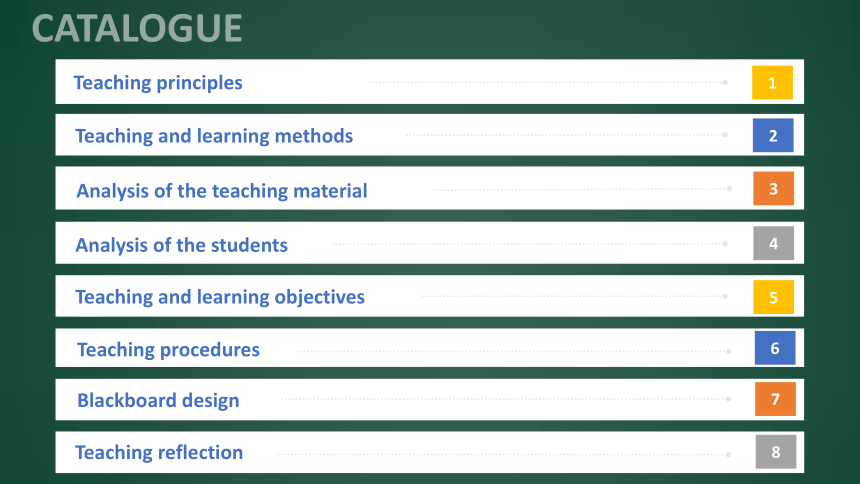

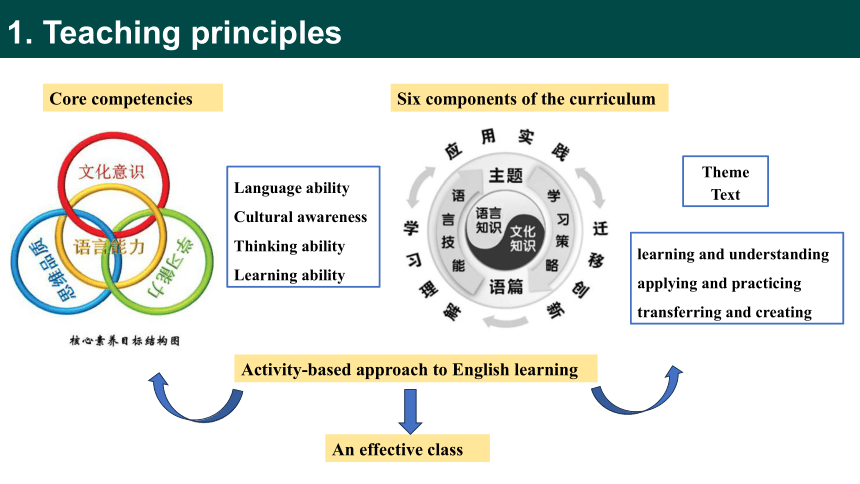
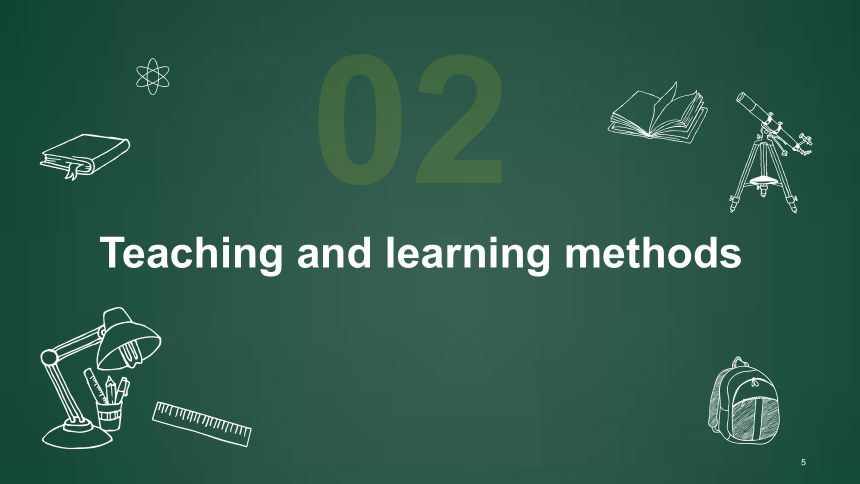
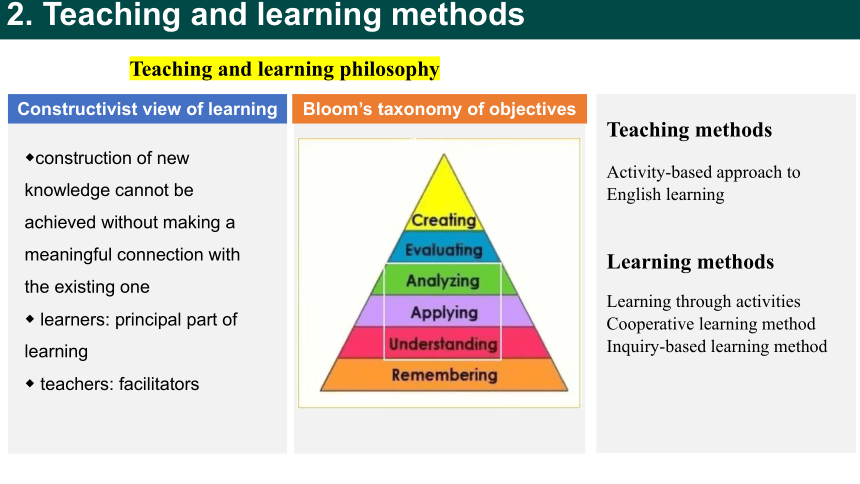
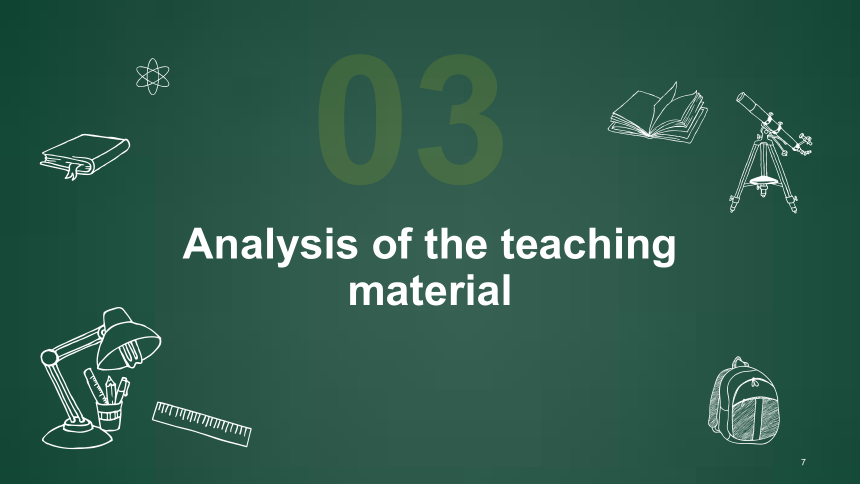
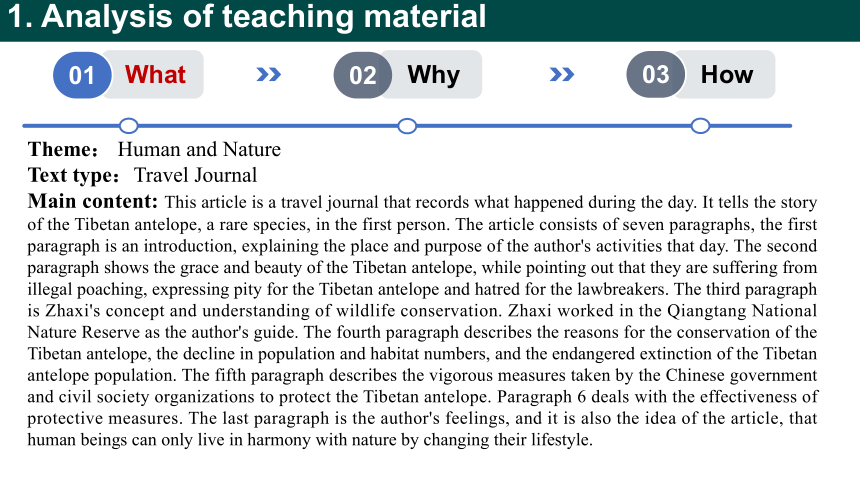

文档简介
(共25张PPT)
B2U2 Wildlife Protection
教学展示
PEP Book2 Senior School English (2019)
The 2 th lesson of Unit 2 Wildlife Protection: Reading and thinking
CATALOGUETeaching and learning methods2Analysis of the teaching material3Analysisofthe students4Teachingand learning objectives5Teaching principles1678TeachingproceduresBlackboard designTeachingreflection01Teaching principles1. Teaching principles
Core competencies
Six components of the curriculum
Activity-based approach to English learning
An effective class
learning and understanding
applying and practicing
transferring and creating
Language ability
Cultural awareness
Thinking ability
Learning ability
Theme
Text
02Teachingand learningmethods2. Teaching and learning methods
Bloom’s taxonomy of objectives
Constructivist view of learning
◆construction of new knowledge cannot be achieved without making a meaningful connection with the existing one
◆ learners: principal part of learning
◆ teachers: facilitators
Teaching methods
Learning methods
Activity-based approach to English learning
Learning through activities
Cooperative learning method
Inquiry-based learning method
Teaching and learning philosophy
03Analysis of the teaching material1. Analysis of teaching material
What
02
Why
01
How
03
Theme: Human and Nature
Text type:Travel Journal
Main content: This article is a travel journal that records what happened during the day. It tells the story of the Tibetan antelope, a rare species, in the first person. The article consists of seven paragraphs, the first paragraph is an introduction, explaining the place and purpose of the author's activities that day. The second paragraph shows the grace and beauty of the Tibetan antelope, while pointing out that they are suffering from illegal poaching, expressing pity for the Tibetan antelope and hatred for the lawbreakers. The third paragraph is Zhaxi's concept and understanding of wildlife conservation. Zhaxi worked in the Qiangtang National Nature Reserve as the author's guide. The fourth paragraph describes the reasons for the conservation of the Tibetan antelope, the decline in population and habitat numbers, and the endangered extinction of the Tibetan antelope population. The fifth paragraph describes the vigorous measures taken by the Chinese government and civil society organizations to protect the Tibetan antelope. Paragraph 6 deals with the effectiveness of protective measures. The last paragraph is the author's feelings, and it is also the idea of the article, that human beings can only live in harmony with nature by changing their lifestyle.
1. Analysis of teaching material
What
01
Why
02
How
03
Through reading the texts, students learn about the conservation measures and achievements of the government and non-governmental organizations for the rare wild animal Tibetan antelope, and think about how to change their lifestyles and live in harmony with nature.
1. Analysis of teaching material
What
01
Why
03
How
02
The article is well-structured, beautifully written, and presents what the author has seen, heard, and felt. Instruct students to analyze the structure and language characteristics of the journal text, pay attention to the author's description of the scenery and mental activities, learn to master the new vocabulary that appears in the text, expand the topic, and express their own views and opinions on the conservation of wild species. At the same time, students will learn to distinguish the superficial meaning and deep connotation of the reading text, and understand the author's intention and emotional attitude.
In addition, the essay uses figures of speech, such as puns, contrasts, and quotations to make the language infectious, authentic, and vivid.
04Analysis ofstudentsWhat I know
This unit is designed for senior 1 students, who have acquired a certain level of comprehensive English language skills, such as listening, speaking, reading, and writing skills in contexts, as well as a preliminary understanding of self-directed learning, cooperative learning and inquiry-based learning.
What I want to know
The English proficiency of students is uneven, and some students' English proficiency needs to be improved, and students rarely have the opportunity to contact wild animals in their daily lives.
What I learned
After learning this course, it is hoped that the students' awareness and sense of responsibility for animal protection will be enhanced, and they will have a better understanding of the measures and methods of animal protection. From the perspective of language knowledge, the accumulation of language vocabulary may be insufficient, and teachers need to enrich students' language expression through teaching and stimulate students' desire to think and share actively.
2. Analysis of students
05Teachingand learning objectives3. Teaching and learning objectivesText hereFocal pointsText hereDifficult points(1) Grasp the textual characteristics of the journal narrative; Read important information about the conservation of Tibetan antelopes in the text;(2) Share views and opinions on the conservation of wild species, and realize the importance of harmony between man and nature.(3) Excavate the implicit meaning of the text;(4) Describe the threat of human activities to wildlife and measures to protect wildlife in English.1.Figure out the main structure and the text type of the passage through the textual pattern analysis;2.Read and know what people have done to make better living environment for Tibetan antelopes;3.Express ourselves about the ways to care for wildlife.06Teachingprocedures
Step I
Leading-in
Step II
Pre-reading
Step III
While-reading
Step IV
Post-reading
Step V
Conclusion
Step VI
Homework
Perceive the topic: The Tibetan Antelope.
Predict the content and the text style.
Read for the main idea and structure.
Read for detailed information and language features.
Retell the story.
Read for thinking..
Draw a conclusion on today’s topic.
Self-evaluate.
Learning and understanding
Applying and practicing
Transferring and creating
Assign group projects.
6. Teaching procedures
Leading-in & Pre-reading
使用说明&设计意图By looking at pictures and videos, answering questions, and reviewing what they learned in the previous lesson, students will be brought into the theme of this unit, "Wildlife Conservation". Stimulate students' interest in learning and exploration by expanding their interesting knowledge of nature.
6. Teaching procedures
While reading
使用说明&设计意图:
Invite students to read quickly with questions, so that they can learn to grasp the gist of the article through quick browsing, so as to train students to read quickly and improve their ability to read quickly.
Through independent thinking and careful reading of texts with questions, students develop the ability to extract key information. By teaching students how to study and then giving them time to explore the answers independently, students are trained to read carefully.
6. Teaching procedures
Read for the main idea and structure.
Read for detailed information and language features.
Post-reading
使用说明&设计意图:
1.To cultivate students’ ability to analyze and share their opinions.
2.To guide students to think about the relationship between man and nature and discuss what we can do to protect the endangered animals.
6. Teaching procedures
使用说明&设计意图:
Can do & Must do
& cooperate with each other.
To realize the application practice and transfer innovation of the knowledge learned, teachers can also choose to assign homework in layers according to the situation of students.
6. Teaching procedures
07Blackboard design7. Blackboard design
B2U2 Wildlife Protection
Reading and thinking
08Teachingreflection8. Teaching reflection
Compared with the previous units, the learning content of this unit has obviously improved the difficulty. So in the teaching process, teachers should be more patient, preset the problems that students may have in advance, give students more time to prepare for discussion, improve the tolerance for the mistakes made by students, and actively guide them to build up their confidence. Teaching activities must be student-centered and we must pay attention to teaching students in accordance with their aptitude and follow the principle of consistent teaching evaluation. Different students have different goals and tasks to achieve.
设计思路特色与不足
Thank you for
watching.
Speaker name and title
OfficePLUS
hank
B2U2 Wildlife Protection
教学展示
PEP Book2 Senior School English (2019)
The 2 th lesson of Unit 2 Wildlife Protection: Reading and thinking
CATALOGUETeaching and learning methods2Analysis of the teaching material3Analysisofthe students4Teachingand learning objectives5Teaching principles1678TeachingproceduresBlackboard designTeachingreflection01Teaching principles1. Teaching principles
Core competencies
Six components of the curriculum
Activity-based approach to English learning
An effective class
learning and understanding
applying and practicing
transferring and creating
Language ability
Cultural awareness
Thinking ability
Learning ability
Theme
Text
02Teachingand learningmethods2. Teaching and learning methods
Bloom’s taxonomy of objectives
Constructivist view of learning
◆construction of new knowledge cannot be achieved without making a meaningful connection with the existing one
◆ learners: principal part of learning
◆ teachers: facilitators
Teaching methods
Learning methods
Activity-based approach to English learning
Learning through activities
Cooperative learning method
Inquiry-based learning method
Teaching and learning philosophy
03Analysis of the teaching material1. Analysis of teaching material
What
02
Why
01
How
03
Theme: Human and Nature
Text type:Travel Journal
Main content: This article is a travel journal that records what happened during the day. It tells the story of the Tibetan antelope, a rare species, in the first person. The article consists of seven paragraphs, the first paragraph is an introduction, explaining the place and purpose of the author's activities that day. The second paragraph shows the grace and beauty of the Tibetan antelope, while pointing out that they are suffering from illegal poaching, expressing pity for the Tibetan antelope and hatred for the lawbreakers. The third paragraph is Zhaxi's concept and understanding of wildlife conservation. Zhaxi worked in the Qiangtang National Nature Reserve as the author's guide. The fourth paragraph describes the reasons for the conservation of the Tibetan antelope, the decline in population and habitat numbers, and the endangered extinction of the Tibetan antelope population. The fifth paragraph describes the vigorous measures taken by the Chinese government and civil society organizations to protect the Tibetan antelope. Paragraph 6 deals with the effectiveness of protective measures. The last paragraph is the author's feelings, and it is also the idea of the article, that human beings can only live in harmony with nature by changing their lifestyle.
1. Analysis of teaching material
What
01
Why
02
How
03
Through reading the texts, students learn about the conservation measures and achievements of the government and non-governmental organizations for the rare wild animal Tibetan antelope, and think about how to change their lifestyles and live in harmony with nature.
1. Analysis of teaching material
What
01
Why
03
How
02
The article is well-structured, beautifully written, and presents what the author has seen, heard, and felt. Instruct students to analyze the structure and language characteristics of the journal text, pay attention to the author's description of the scenery and mental activities, learn to master the new vocabulary that appears in the text, expand the topic, and express their own views and opinions on the conservation of wild species. At the same time, students will learn to distinguish the superficial meaning and deep connotation of the reading text, and understand the author's intention and emotional attitude.
In addition, the essay uses figures of speech, such as puns, contrasts, and quotations to make the language infectious, authentic, and vivid.
04Analysis ofstudentsWhat I know
This unit is designed for senior 1 students, who have acquired a certain level of comprehensive English language skills, such as listening, speaking, reading, and writing skills in contexts, as well as a preliminary understanding of self-directed learning, cooperative learning and inquiry-based learning.
What I want to know
The English proficiency of students is uneven, and some students' English proficiency needs to be improved, and students rarely have the opportunity to contact wild animals in their daily lives.
What I learned
After learning this course, it is hoped that the students' awareness and sense of responsibility for animal protection will be enhanced, and they will have a better understanding of the measures and methods of animal protection. From the perspective of language knowledge, the accumulation of language vocabulary may be insufficient, and teachers need to enrich students' language expression through teaching and stimulate students' desire to think and share actively.
2. Analysis of students
05Teachingand learning objectives3. Teaching and learning objectivesText hereFocal pointsText hereDifficult points(1) Grasp the textual characteristics of the journal narrative; Read important information about the conservation of Tibetan antelopes in the text;(2) Share views and opinions on the conservation of wild species, and realize the importance of harmony between man and nature.(3) Excavate the implicit meaning of the text;(4) Describe the threat of human activities to wildlife and measures to protect wildlife in English.1.Figure out the main structure and the text type of the passage through the textual pattern analysis;2.Read and know what people have done to make better living environment for Tibetan antelopes;3.Express ourselves about the ways to care for wildlife.06Teachingprocedures
Step I
Leading-in
Step II
Pre-reading
Step III
While-reading
Step IV
Post-reading
Step V
Conclusion
Step VI
Homework
Perceive the topic: The Tibetan Antelope.
Predict the content and the text style.
Read for the main idea and structure.
Read for detailed information and language features.
Retell the story.
Read for thinking..
Draw a conclusion on today’s topic.
Self-evaluate.
Learning and understanding
Applying and practicing
Transferring and creating
Assign group projects.
6. Teaching procedures
Leading-in & Pre-reading
使用说明&设计意图By looking at pictures and videos, answering questions, and reviewing what they learned in the previous lesson, students will be brought into the theme of this unit, "Wildlife Conservation". Stimulate students' interest in learning and exploration by expanding their interesting knowledge of nature.
6. Teaching procedures
While reading
使用说明&设计意图:
Invite students to read quickly with questions, so that they can learn to grasp the gist of the article through quick browsing, so as to train students to read quickly and improve their ability to read quickly.
Through independent thinking and careful reading of texts with questions, students develop the ability to extract key information. By teaching students how to study and then giving them time to explore the answers independently, students are trained to read carefully.
6. Teaching procedures
Read for the main idea and structure.
Read for detailed information and language features.
Post-reading
使用说明&设计意图:
1.To cultivate students’ ability to analyze and share their opinions.
2.To guide students to think about the relationship between man and nature and discuss what we can do to protect the endangered animals.
6. Teaching procedures
使用说明&设计意图:
Can do & Must do
& cooperate with each other.
To realize the application practice and transfer innovation of the knowledge learned, teachers can also choose to assign homework in layers according to the situation of students.
6. Teaching procedures
07Blackboard design7. Blackboard design
B2U2 Wildlife Protection
Reading and thinking
08Teachingreflection8. Teaching reflection
Compared with the previous units, the learning content of this unit has obviously improved the difficulty. So in the teaching process, teachers should be more patient, preset the problems that students may have in advance, give students more time to prepare for discussion, improve the tolerance for the mistakes made by students, and actively guide them to build up their confidence. Teaching activities must be student-centered and we must pay attention to teaching students in accordance with their aptitude and follow the principle of consistent teaching evaluation. Different students have different goals and tasks to achieve.
设计思路特色与不足
Thank you for
watching.
Speaker name and title
OfficePLUS
hank
